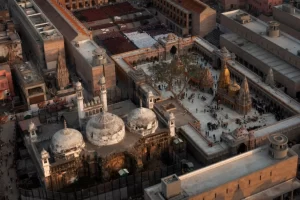14 Sep Court allows hearing of Hindu plea for the right to pray in Gyanvapi mosque
Prelim: International and national and Indian history and culture
Mains Examination: GS paper II: Structure, organization, and functioning of the Executive and the Judiciary
Why it is in the news?
Varanasi court allows hearing of Hindu plea for the right to pray in Gyanvapi mosque.

The backstory :
- The Gyanvapi Mosque was built during the reign of the Mughal emperor Aurangzeb, in 1669,
- He ordered the demolition of the existing Vishweshwar temple at the site, and build a mosque in place of it.
- This is mentioned in the 1937 book, ‘History of Benares: From the Earliest Times Down to 1937’, by A S Altekar,
- The pedestal of the temple was not changed and served as the courtyard of the mosque.
- One of the walls too was spared, and it became the qibla wall of the mosque, a wall in a mosque that faces Mecca.
- Debris from the destroyed temple was used to build the mosque, evidence of which can still be seen.
- The name of the mosque is said to have derived from an adjoining wall, the Gyanvapi, or Well of Knowledge.
- An old sculpture of the Nandi bull inside the compound of the present Kashi Vishwanath Temple faces the wall of the mosque instead of the sanctum sanctorum of the temple.
- It is believed that Nandi is in fact, facing the sanctum sanctorum of the original Vishweshwar temple.
About the Temple
- For more than a century, after the mosque was built by Aurangzeb in1669, there was no temple at the site.
- The present Kashi Vishwanath Temple was built by Rani Ahilyabai Holkar of Indore, immediately to the south of the mosque, in the 18th century.
- It is a long belief of the Hindu community, the original lingam of the erstwhile Vishwerhwar temple was hidden by the priest inside the GyanVapi well, during Aurangzeb’s raid.
The present story –
- On August 18, 2021, in Varanasi court, five women filed a petition demanding to worship in the temple of Mother Makeup Gauri, a hearing to which the court constituted a commission to know more about the present situation of the Makeup Gauri Temple.
- In this regard, the court had asked the commission head, Vijay Shankar Rastogi, to give the survey report by video graphing the idol of Makeup Gauri and the Gyanvapi complex, brought a cause to outburst, raising questions about the impartiality of the court commissioner appointed by the Muslim side for the survey.
- Vijay Shankar Rastogi, appearing on behalf of Hindus, has submitted a map of the entire Gyanvapi complex as evidence in the court, which mentions the temples of Hindu deities around after the entrance of the mosque, as well as the Vishweshwar temple, Gyankoop, the big Nandi and the basement of the Vyas family. There has been a controversy over the survey and videography of this basement.
- In the meanwhile, the Muslim side says that no decision can be given on the dispute under the Religious Places Act of 1991.
What is The Religious Place Act of 1991 ?
The act states that,“An Act to prohibit conversion of any place of worship and to provide for the maintenance of the religious character of any place of worship as it existed on the 15th day of August, 1947, and for matters connected therewith or incidental thereto.
The provisions of The Religious Place Act of 1991
- Section 3: Section 3 of this Act, bars the conversion, in full or part, of a place of worship of any religious denomination into a place of worship of a different religious denomination or even a different segment of the same religious denomination.
- Section 4(1): It states that the religious character of a place of worship “shall continue to be the same as it existed” on 15th August 1947.
- Section 4(2): It says any suit or legal proceeding with respect to the conversion of the religious character of any place of worship existing on 15th August 1947, pending before any court, shall abate and no fresh suit or legal proceedings shall be instituted.
- Section 5: It specifies that the Act shall not apply to the Ramjanmabhoomi-Babri Masjid case, and to any suit, appeal, or proceeding relating to it.
Sources
- bit.ly/3RI5aiZ(TheIndianExpress)(What is the dispute around the Gyanvapi mosque-Kashi Vishwanath temple complex in Varanasi?)
- https://bit.ly/3BBQlc6(TheIndianExpress)(Varanasi court allows hearing of Hindu plea for the right to pray in Gyanvapi mosque)
- https://bit.ly/3DotvpJ(TheIndianExpress)(the Religious Place of Act of 1991 )
Plutus IAS current affairs eng med 14th Sep 2022PM



No Comments